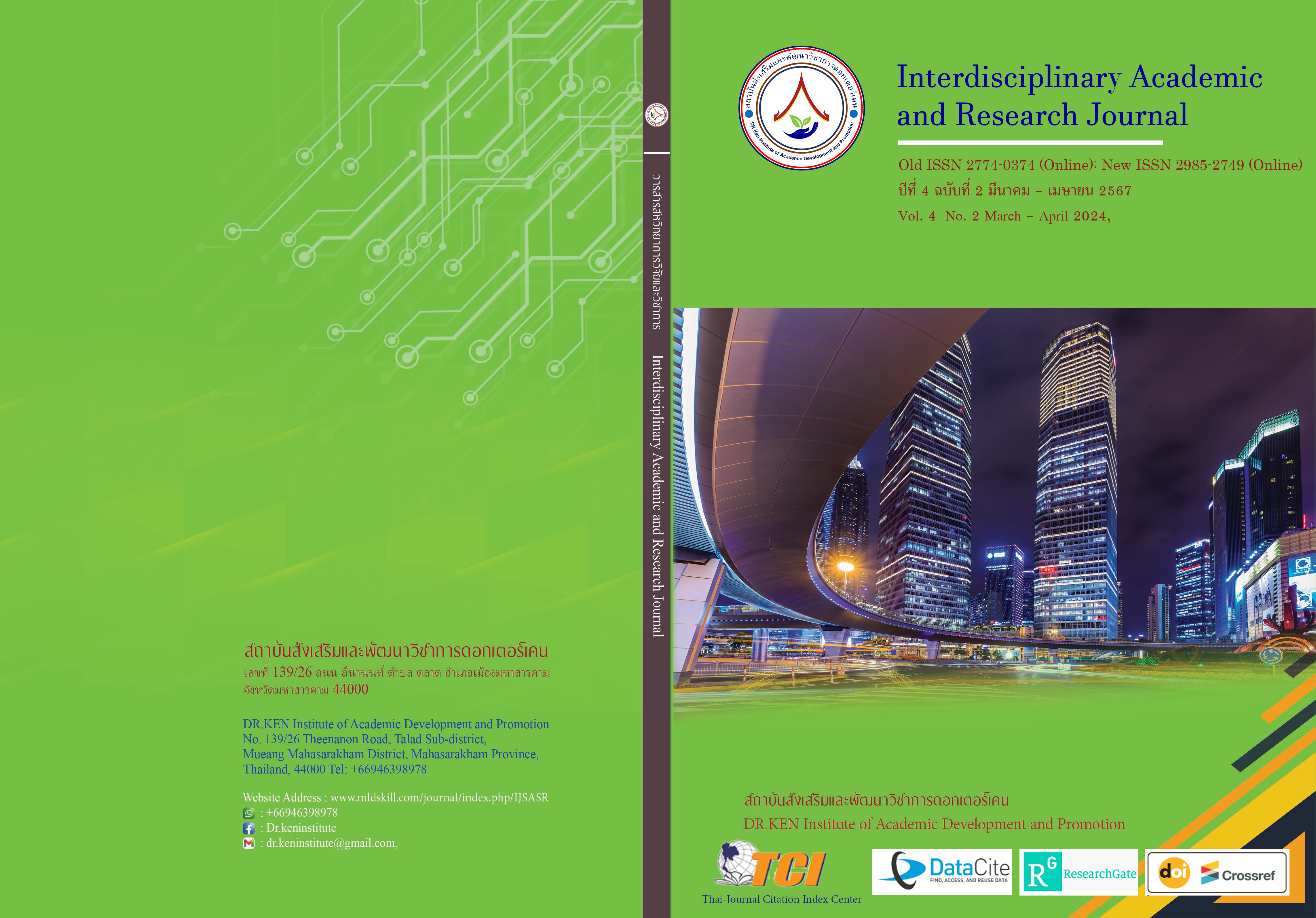The Development of Instructional Packages on Virtue Morality and Teacher Code of Conduct using the Cooperative Learning Technique for Students with a Graduate Diploma Students in Teaching Profession Ubon Ratchathani Rajabhat University
DOI:
https://doi.org/10.60027/iarj.2024.275238Keywords:
Instructional Packages; , Virtue, Morality, Teacher Code of Conduct; , Cooperative Learning TechniqueAbstract
Background and Aims: Collaborative learning is an approach to learning that prioritizes the learners themselves because it offers a variety of teaching formats tailored to the learning objectives. Learners collaborate and assist each other in the learning process. This research aimed (1) to develop teaching packages in Virtue Morality and Teacher Code of Conduct using the Cooperative learning technique criteria at 80/80 (2) to study the effectiveness index of the teaching package before and after using the packages, (3) to study the satisfaction of the packages.
Methodology: The research methodology is quantitative research. The target audience was 60 students majoring in a graduate diploma (teaching profession) in the first-semester academic year 2023 using a purposive sampling method. The teaching packages were implemented in the first semester of the academic year 2023. The researcher used three packages. The instruments in the research were six units of the teaching packages, the achievement test, and the questionnaire. The index of discrimination and reliability was .852. The data were analyzed by arithmetic mean, standard deviation, percentage, and effectiveness index (E.I).
Results: (1) The developed packages were efficient as they exceeded the standard criteria of 81.21/84.48. (2) The effectiveness index (E.I) of the student's achievement after using the package set is equal to 0.7242, indicating that students have progressively increased learning by 72.42 (3) The packages were rated by the students at a high level as a whole, by domain, and by item.
Conclusion: Collaborative learning is a method of managing learning where students collaborate and assist each other in learning by dividing them into small groups with varying abilities. This grouping is characterized by clear and structured teamwork. There is collaborative work, exchange of ideas, mutual support and reliance, and shared responsibility both individually and collectively.
References
กนกลักษณ์ ดวงศรี. (2563). ผลการจัดการเรียนรู้แบบร่วมมือด้วยเทคนิค STAD โดยใช้กิจกรรมเกม และแผ่นภาพการ์ตูน กลุ่มสาระการเรียนรู้ภาษาต่างประเทศ (ภาษาจีน) เรื่องภาษาจีนขั้นพื้นฐาน สำหรับนักเรียนชั้นประถมศึกษาปีที่ 4. วารสารมหาจุฬาตานี ปริทรรศน์, 2(4), 20-27.
กรมวิชาการ กระทรวงศึกษาธิการ. (2564). เอกสารชุดเทคนิคการจัดกระบวนการเรียนรู้ที่ผู้เรียนสําคัญที่สุด การจัดการเรียนรู้แบบร่วมมือ. กรุงเทพมหานคร: โรงพิมพ์การศาสนา กรมศาสนา
เฉลิมพล มีชัย. (2565). การพัฒนาชุดการสอนรายวิชาหัวข้อพิเศษด้านนวัตกรรมการจัดการศึกษาโดยใช้เทคนิคการเรียนรู้แบบผสมผสาน. วารสารวิชาการ การจัดการภาครัฐและเอกชน, 4(2), 13-26.
ดนุพล สืบสำราญ. (2565). การจัดการเรียนรู้โดยใช้รูปแบบการเรียนรู้แบบร่วมมือ เพื่อเปรียบเทียบทักษะการเรียนรู้และประเมินความพึงพอใจ ของนักเรียนระดับประถมศึกษา ในพื้นที่จังหวัดศรีสะเกษ. วารสารวิชาการและวิจัย มหาวิทยาลัยภาคตะวันออกเฉียงเหนือ, 12(3), 211-226.
ทอฝัน แววกระโทก. (2565). การศึกษาผลสัมฤทธิ์ทางการเรียนและความพึงพอใจต่อการจัดการเรียนรู้ แบบร่วมมือด้วยเทคนิค STAD รายวิชาคณิตศาสตร์ของนักเรียน ชั้นประถมศึกษาปีที่ 5. วารสารนวัตกรรมการจัดการศึกษาและการวิจัย, 4(2), 27-42.
ประกายแก้ว แปรโคกสูง. (2541). ประสิทธิภาพการสอนสุขศึกษาและพลศึกษา. บุรีรัมย์: บุรีรัมย์การพิมพ์.
พระบุญเพ็ง สิทธิวงษา. (2561). การพัฒนาชุดกิจกรรมการเรียนรู้แบบร่วมมือโดยใช้เทคนิคจิ๊กซอว์ หน่วยการเรียนรู้ที่ 5. วารสารวิชาการและวิจัย มหาวิทยาลัยภาคตะวันออกเฉียงเหนือ, 8(3), 42-53.
เพ็ญยุพา คําแก้ว. (2563). การพัฒนากิจกรรมทางภาษาอังกฤษเพื่อการสื่อสาร โดยใช้การจัดการเรียนรู้แบบวมมือสําหรับนักเรียนระดับมัธยมศึกษาตอนต้นศูนย์การศึกษานอกระบบและการศึกษาตามอัธยาศัย. สาขาวิจัยและประเมินผลการศึกษา มหาวิทยาลัยราชภัฏมหาสารคาม
มหาวิทยาลัยราชภัฏอุบลราชธานี. (2566). เอกสารประกอบการสอนวิชารายวิชาคุณธรรม จริยธรรม และจรรยาบรรณสำหรับครู. มหาวิทยาลัยราชภัฏอุบลราชธานี. อุบลราชธานี.
รัชพล ครองยุติ. (2565). การพัฒนารูปแบบการสอนบทเรียนออนไลน์ รายวิชาวิทยาการคำนวณ ตามทฤษฎีการเรียนรู้แบบร่วมมือ. วารสารการบริหารนิติบุคคลและนวัตกรรมท้องถิ่น, 8(12), 217-227.
วิจารณ์ พานิช. (2560). วิถีสร้างการเรียนรู้เพื่อศิษย์ในศตวรรษที่ 21. กรุงเทพฯ : มูลนิธิสดศรี -. สฤษดิ์วงศ์.
วิมาน ใจดี. (2564). การพัฒนาสื่อการเรียนรู้ด้วยเทคโนโลยีความเป็นจริงเสริม รายวิชาคณิตศาสตร์ ร่วมกับการเรียนรู้แบบร่วมมือด้วยเทคนิคกลุ่มแข่งขัน เพื่อพัฒนาผลสัมฤทธิ์ทางการเรียนของนักเรียนชั้นประถมศึกษาปีที่ 6. วารสารศึกษาศาสตร์ มมร, 9(2), 355-370.
วีรวิชญ์ เลิศรัตน์ธำรงกุล. (2563). การพัฒนาบทเรียนบนเว็บที่ใช้วิธีการเรียนรู้แบบร่วมมือ วิชากฎหมายเทคโนโลยีสารสนเทศที่ส่งเสริมทักษะการคิดอย่างมีวิจารณญาณของนักศึกษาปริญญาตรี มหาวิทยาลัยภาคตะวันออกเฉียงเหนือ. วารสารวิชาการและวิจัย มหาวิทยาลัยภาคตะวันออกเฉียงเหนือ, 10(2), 22-40.
สำนักงานคณะกรรมการมาตรฐานการอุดมศึกษา. (2565). กฎกระทรวงเกี่ยวกับมาตรฐานการอุดมศึกษาและแนวปฏิบัติการเสนอหลักสูตรการศึกษาระดับอุดมศึกษา. อนุสารอุดมศึกษา, 48(527), 18-21.
สุปรียา ไผ่ล้อม. (2563). การศึกษาผลการจัดการเรียนรู้และความพึงพอใจของนักเรียนชั้นประถมศึกษาปีที่ 4 เรื่อง พลเมืองต้นแบบโดยใช้วิธีสอนแบบร่วมมือรูปแบบร่วมเรียนรู้ (Learning Together : LT). วารสารเทคโนโลยีและสื่อสารการศึกษา, 3(7), 125-137.
อาภรณ์ ใจเที่ยง. (2550). หลักการสอน ฉบับปรับปรุง. พิมพ์ครั้งที่ 4. กรุงเทพมหานคร: โอเดียนสโตร์.
Anchunda, H.Y. ., & Kaewurai, W. (2021). Instructional model development based on collaborative and communicative approaches to enhance lower secondary students’ English-speaking skills in Thailand. Kasetsart Journal of Social Sciences, 42(2), 287–292. Retrieved fromhttps://so04.tcithaijo.org/ index.php /kjss/ article/view/250923
Brown, J. W. (1973). Instruction Technology, Media, and Method. New York: McGraw-Hill.
Good, G.J., (1973). How important is a specialist classroom environment for language? Christchurch College of Education.The New Zealand Language Teacher, 106
Houston, R.W., & et al. (1972). Developing Instruction Modules. College of. Education. Texas: University of Houston. Page 96. 86.
Kapfer, P.G., & Kapter, M.B. (1972). Learning Pagage in American Education. Englewood cliffs. N.T.; Education Technology Publication.
Downloads
Published
How to Cite
Issue
Section
License
Copyright (c) 2024 Interdisciplinary Academic and Research Journal

This work is licensed under a Creative Commons Attribution-NonCommercial-NoDerivatives 4.0 International License.
Copyright on any article in the Interdisciplinary Academic and Research Journal is retained by the author(s) under the under the Creative Commons Attribution-NonCommercial-NoDerivatives 4.0 International License. Permission to use text, content, images, etc. of publication. Any user to read, download, copy, distribute, print, search, or link to the full texts of articles, crawl them for indexing, pass them as data to software, or use them for any other lawful purpose. But do not use it for commercial use or with the intent to benefit any business.
















.png)


